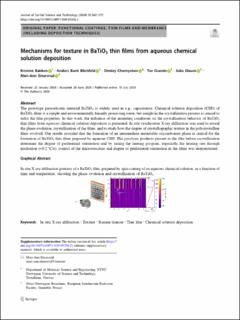| dc.contributor.author | Bakken, Kristine | |
| dc.contributor.author | Blichfeld, Anders Bank | |
| dc.contributor.author | Chernyshov, Dmitry | |
| dc.contributor.author | Grande, Tor | |
| dc.contributor.author | Glaum, Julia | |
| dc.contributor.author | Einarsrud, Mari-Ann | |
| dc.date.accessioned | 2021-02-10T11:57:35Z | |
| dc.date.available | 2021-02-10T11:57:35Z | |
| dc.date.created | 2020-09-04T10:55:35Z | |
| dc.date.issued | 2020 | |
| dc.identifier.citation | Journal of Sol-Gel Science and Technology. 2020, 95 562-572. | en_US |
| dc.identifier.issn | 0928-0707 | |
| dc.identifier.uri | https://hdl.handle.net/11250/2727178 | |
| dc.description.abstract | The prototype piezoelectric material BaTiO3 is widely used in e.g., capacitators. Chemical solution deposition (CSD) of BaTiO3 films is a simple and environmentally friendly processing route, but insight in the crystallization process is crucial to tailor the film properties. In this work, the influence of the annealing conditions on the crystallization behavior of BaTiO3 thin films from aqueous chemical solution deposition is presented. In situ synchrotron X-ray diffraction was used to reveal the phase evolution, crystallization of the films, and to study how the degree of crystallographic texture in the polycrystalline films evolved. Our results revealed that the formation of an intermediate metastable oxycarbonate phase is critical for the formation of BaTiO3 thin films prepared by aqueous CSD. The pyrolysis products present in the film before crystallization determine the degree of preferential orientation and by tuning the heating program, especially the heating rate through nucleation (<0.2 °C/s), control of the microstructure and degree of preferential orientation in the films was demonstrated. | en_US |
| dc.language.iso | eng | en_US |
| dc.publisher | Springer | en_US |
| dc.relation.uri | https://doi.org/10.1007/s10971-020-05356-2 | |
| dc.rights | Navngivelse 4.0 Internasjonal | * |
| dc.rights.uri | http://creativecommons.org/licenses/by/4.0/deed.no | * |
| dc.title | Mechanisms for texture in BaTiO3 thin films from aqueous chemical solution deposition | en_US |
| dc.type | Journal article | en_US |
| dc.type | Peer reviewed | en_US |
| dc.description.version | publishedVersion | en_US |
| dc.source.pagenumber | 562-572 | en_US |
| dc.source.volume | 95 | en_US |
| dc.source.journal | Journal of Sol-Gel Science and Technology | en_US |
| dc.identifier.doi | 10.1007/s10971-020-05356-2 | |
| dc.identifier.cristin | 1827321 | |
| dc.relation.project | Norges forskningsråd: 250403 | en_US |
| cristin.ispublished | true | |
| cristin.fulltext | original | |
| cristin.qualitycode | 1 | |

